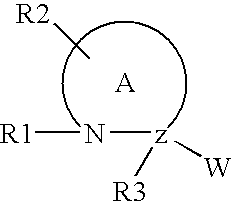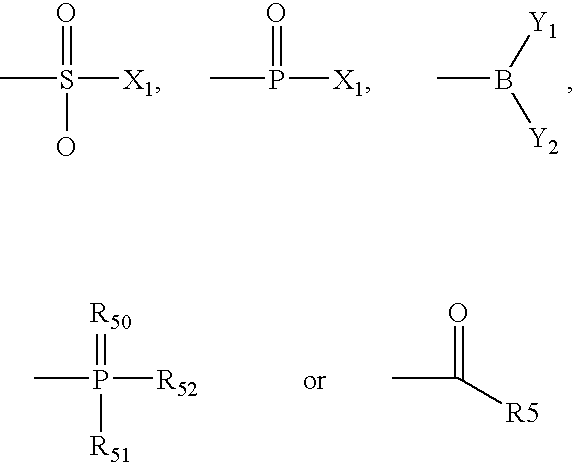Method of regulating glucose metabolism, and reagents related thereto
a glucose metabolism and glucose technology, applied in the direction of phosphorous compound active ingredients, drug compositions, metabolic disorders, etc., can solve the problems of uncontrollable hyperglycemia, insufficient amount of insulin, adversely affecting the way the body uses sugar, and insufficient glucose metabolism
- Summary
- Abstract
- Description
- Claims
- Application Information
AI Technical Summary
Benefits of technology
Problems solved by technology
Method used
Image
Examples
example 2
[0285] Preparation of BoroProline-Pinacol
[0286] The intermediate, 4-Bromo-1-chlorobutyl boronate pinacol, was prepared by the method in Matteson et al. (Organometallics 3:1284, 1984) except that conditions were modified for large scale preparations and pinacol was substituted for the pinanediol protecting group.
[0287] 3-bromopropyl boronate pinacol was prepared by hydrogenboronation of allyl bromide (173 ml, 2.00 moles) with catechol borane (240 ml, 2.00 moles). Catechol borane was added to allyl bromide and the reaction heated for 4 hours at 100.degree. C. under a nitrogen atmosphere. The product, 3-bromopropyl boronate catechol (bp 95-102.degree. C., 0.25 mm), was isolated in a yield of 49% by distillation. The catechol ester (124 g, 0.52 moles) was transesterified with pinacol (61.5 g, 0.52 moles) by mixing the component in 50 ml of THF and allowing them to stir for 0.5 hours at 0.degree. C. and 0.5 hours at room temperature. Solvent was removed by evaporation and 250 ml of hexan...
example 3
[0291] Synthesis of BoroProline Peptides
[0292] General methods of coupling of N-protected peptides and amino acids with suitable side-chain protecting groups to H-boroProline-pinacol are applicable. When needed, side-chain protecting and N-terminal protecting groups can be removed by treatment with anhydrous HCl, HBr, trifluoroacetic acid, or by catalytic hydrogenation. These procedures are known to those skilled in the art of peptide synthesis.
[0293] The mixed anhydride procedure of Anderson et al. (J. Am. Chem. Soc. 89:5012, 1984) is preferred for peptide coupling. Referring again to FIG. 1, the mixed anhydride of an N-protected amino acid or a peptide is prepared by dissolving the peptide in tetrahydrofuran and adding one equivalent of N-methylmorpholine. The solution is cooled to -20.degree. C. and an equivalent of isobutyl chloroformate is added. After 5 minutes, this mixture and one equivalent of triethylamine (or other sterically hindered base) are added to a solution of H-bo...
example 4
[0297] Preparation of H-Ala-boroPro
[0298] Boc-Ala-boroPro was prepared by mixed anhydride coupling of the N-Boc-protected alanine and H-boroPro prepared as described above. H-Ala-boroPro (Ala-boropro) was prepared by removal of the Boc protecting group at 0.degree. C. in 3.5 molar excess of 4N HCl-dioxane. The coupling and deblocking reactions were performed by standard chemical reaction. Ala-boroPro has a K.sub.i for DP-IV of in the nanomolar range. Boc-blocked Ala-boroPro has no affinity for DP-IV.
[0299] The two diastereomers of Ala-boroPro-pinacol, L-Ala-D-boroPro-pinacol and L-Ala-L-boroPro-pinacol, can be partially separated by silica gel chromatography with 20% methanol in ethyl acetate as eluant. The early fraction appears by NMR analysis to be 95% enriched in one isomer. Because this fraction has more inhibits DP-IV to a greater extent than later fractions (at equal concentrations) it is probably enriched in the L-boroPro (L-Ala-L-boroPro-pinacol) isomer.
PUM
| Property | Measurement | Unit |
|---|---|---|
| volume | aaaaa | aaaaa |
| body weight | aaaaa | aaaaa |
| temperature | aaaaa | aaaaa |
Abstract
Description
Claims
Application Information
 Login to View More
Login to View More - R&D
- Intellectual Property
- Life Sciences
- Materials
- Tech Scout
- Unparalleled Data Quality
- Higher Quality Content
- 60% Fewer Hallucinations
Browse by: Latest US Patents, China's latest patents, Technical Efficacy Thesaurus, Application Domain, Technology Topic, Popular Technical Reports.
© 2025 PatSnap. All rights reserved.Legal|Privacy policy|Modern Slavery Act Transparency Statement|Sitemap|About US| Contact US: help@patsnap.com



